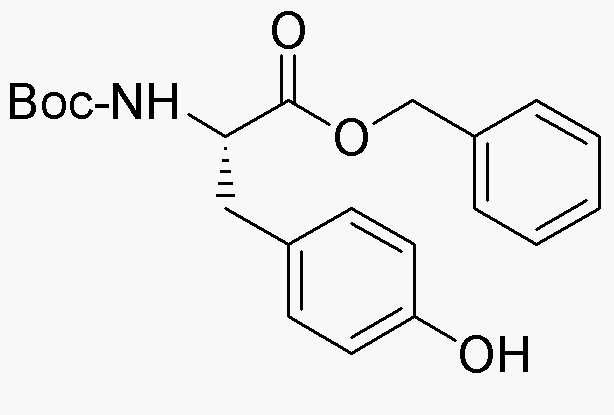Boc-L-tyrosine benzyl ester is widely utilized in research focused on:
- Peptide Synthesis: This compound serves as a key building block in the synthesis of peptides, allowing researchers to create specific sequences for studying protein interactions and functions.
- Drug Development: It is used in the development of pharmaceutical compounds, particularly in creating prodrugs that improve the bioavailability of therapeutic agents.
- Bioconjugation: The chemical's reactive groups facilitate bioconjugation processes, enabling the attachment of drugs or imaging agents to biomolecules for targeted therapies.
- Research in Neuroscience: Due to its structural similarity to neurotransmitters, it aids in the study of neurochemical pathways and the development of treatments for neurological disorders.
- Cosmetic Formulations: Its properties are leveraged in cosmetic chemistry to enhance formulations aimed at skin health, particularly in products targeting aging and hydration.
Información general
Propiedades
Seguridad y normativas
Aplicaciones
Boc-L-tyrosine benzyl ester is widely utilized in research focused on:
- Peptide Synthesis: This compound serves as a key building block in the synthesis of peptides, allowing researchers to create specific sequences for studying protein interactions and functions.
- Drug Development: It is used in the development of pharmaceutical compounds, particularly in creating prodrugs that improve the bioavailability of therapeutic agents.
- Bioconjugation: The chemical's reactive groups facilitate bioconjugation processes, enabling the attachment of drugs or imaging agents to biomolecules for targeted therapies.
- Research in Neuroscience: Due to its structural similarity to neurotransmitters, it aids in the study of neurochemical pathways and the development of treatments for neurological disorders.
- Cosmetic Formulations: Its properties are leveraged in cosmetic chemistry to enhance formulations aimed at skin health, particularly in products targeting aging and hydration.
Documentos
Hojas de datos de seguridad (HDS)
La SDS proporciona información de seguridad completa sobre la manipulación, el almacenamiento y la eliminación del producto.
Especificación del producto (PS)
La PS proporciona un desglose completo de las propiedades del producto, incluida la composición química, el estado físico, la pureza y los requisitos de almacenamiento. También detalla los rangos de calidad aceptables y las aplicaciones previstas del producto.
Certificados de análisis (COA)
Busque certificados de análisis (COA) ingresando el número de lote del producto. Los números de lote y de partida se pueden encontrar en la etiqueta de un producto después de las palabras "Lote" o "Lote".
Número de catálogo
Número de lote/lote
Certificados de origen (COO)
Este certificado de origen confirma el país en el que se fabricó el producto y también detalla los materiales y componentes utilizados en él y si se deriva de fuentes naturales, sintéticas u otras fuentes específicas. Este certificado puede ser necesario para cumplir con las normativas aduaneras, comerciales y regulatorias.
Número de catálogo
Número de lote/lote
Hojas de datos de seguridad (HDS)
La SDS proporciona información de seguridad completa sobre la manipulación, el almacenamiento y la eliminación del producto.
DownloadEspecificación del producto (PS)
La PS proporciona un desglose completo de las propiedades del producto, incluida la composición química, el estado físico, la pureza y los requisitos de almacenamiento. También detalla los rangos de calidad aceptables y las aplicaciones previstas del producto.
DownloadCertificados de análisis (COA)
Busque certificados de análisis (COA) ingresando el número de lote del producto. Los números de lote y de partida se pueden encontrar en la etiqueta de un producto después de las palabras "Lote" o "Lote".
Número de catálogo
Número de lote/lote
Certificados de origen (COO)
Este certificado de origen confirma el país en el que se fabricó el producto y también detalla los materiales y componentes utilizados en él y si se deriva de fuentes naturales, sintéticas u otras fuentes específicas. Este certificado puede ser necesario para cumplir con las normativas aduaneras, comerciales y regulatorias.


